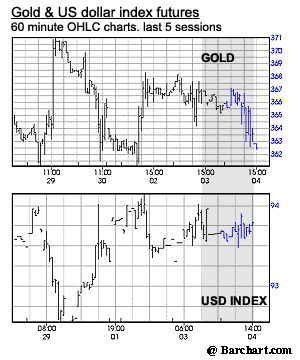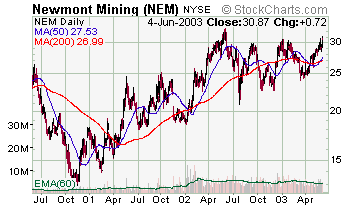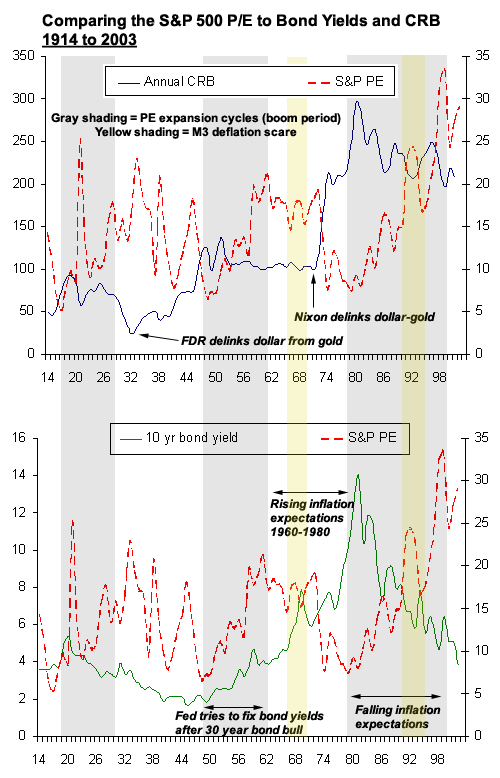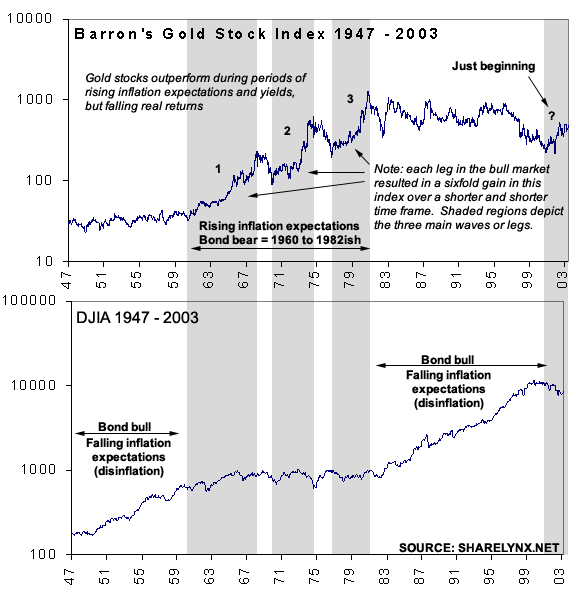|
 We
appear headed for another test of the $360 level on gold, as the
dollar bullish environment on Wall Street extended yet another day. We
appear headed for another test of the $360 level on gold, as the
dollar bullish environment on Wall Street extended yet another day.
The Dow continues to defy our bearish
call, and surged another 116 points to close at 9039 Wednesday.
The bulls made a higher intermediate
high intraday, but closed four points below December's (intraday)
high, so I wouldn't call it a signal yet, even though it might be
by Friday.
Moreover, key intermediate resistance
is at August's (2002) high - 9077.
The odd thing about this rally is
that the bulls are cautious. The headlines read "is this
for real," rather than, "choo, choo, the train's
leaving the station." Even Tom Gavin - whose remaining
clients could well be hanging on to the stocks they bought three
years ago - sees a pullback here, as well as a much less rewarding
stock market environment going forward than was the case during
the nineties.
Our sentiment indicators are mixed.
Some are showing extreme bullish
sentiment, while others suggest there is room for this sentiment
to grow. None suggest too many bears.
 The
CBOE's put/call ratio suggests there's room for bulls to get more
bullish. The
CBOE's put/call ratio suggests there's room for bulls to get more
bullish.
The indicator set off an incorrect
sell signal in April. Then
a correct one a month later - in the middle of May.
But it was immediately followed by
a buy signal - too many bears.
Since then, it appears bullish sentiment
has been rising more cautiously. I don't know what's going to happen
next.
The shorts might as well be careful
here. The environment isn't unfriendly, but it might pay to wait
out either a crack in momentum or a clearer reading from the sentiment
indicators. In the near term, much may depend on the labor
news this week.
Meanwhile, the bond market isn't
letting up. Players could be acting out a little war anxiety, or
they may be betting on a bad labor report, or they are bullish on
deflation and the prospect of a Fed yield cap, or they're just momentum
trading.
At any rate, whatever is driving
the bond, the strength in the bond is driving stocks, higher. As
for stocks, whether it's falling yields, or the falling dollar,
or the recovering economy or profit boom, there is inflation everywhere
at the moment.
That much we can all agree (defining
it as too much money/credit) I hope.
Indeed, as long as it isn't perceived,
yields can be managed. And as long as yields can be lowered, or
kept low, stock values could rise further - at least until they
approach full valuations (which we guestimate at about 1050 to 1100
for the S&P 500 today; don't ask what the other side of that
range is).
I believe the falling bond yield
is the single most influential factor in this stock rally thus far.
So it shouldn't surprise you
to see the Dow continue to rise so long as yields remain low, or
fail to discount the true inflation picture.
And as long as it continues, it's
bullish for the dollar.
My main outlook for the Dow is that
the rally will end when yields spike, which I argue they'll do when
the market begins to discount the inflation picture as we see it
today.
But so far the stock markets continue
to inch higher, with hardly an impact on bond yields. What gives?
What's the rationale for buying bonds offering yields near 45-year
lows when:
- the dollar is reeling,
- the budget deficit is soaring,
- the trade deficit is soaring,
- forward and trailing PE ratios
for the S&P 500 are still near record highs,
- gold is near six year highs,
- commodity prices rose at their
fastest pace in 20 years in 2002, and
- monetary aggregates have been
growing at their fastest pace in two decades
I can't stress enough that productivity
alone can't sustain these RECORD bearish imbalances, or divergences.
Neither can the historical record find many examples when during
such conditions bond yields continued to fall.
So we have to look to unconventional
explanations, such as the possibility of deflation, or manipulation,
or the Fed's forecast use of unconventional tools, or even delusion.
Gold Stocks, Inflation, Yields,
and the DJIA in the 20th Century
Gold stocks have been surprisingly
strong in spite of the dollar's tiny bounce this week. Even Wednesday
as gold prices fell, and the dollar recovered some ground against
the Euro, Swiss Franc, Rand, and Mexican peso - it rose sharply
relative to the latter two - gold stocks gained.
 Newmont
led the S&P gold sector index to a higher intermediate high,
and now approaches last June's high at $32.75 for Newmont (and about
81 for the index). Newmont
led the S&P gold sector index to a higher intermediate high,
and now approaches last June's high at $32.75 for Newmont (and about
81 for the index).
They closed at $30.87 and 72.7 respectively,
which are their best levels since.
Still, the picture was mixed in this
sector Wednesday. Decent gains
in the blue chips were offset by losses in the speculative end of
the market.
Overall the charts of gold stocks
aren't very telling. There has been an increasing bullish bias within
the one year trading range most of them have been stuck in.
We were asked by a client to find
some data on how gold stocks had performed during the seventies
environment - which happens to be our model for the future.
So let's recap and define our model
briefly.
First, we assume that inflation is
a constant. There is no deflation in our model (which I think is
reasonable so long as there is central banking, an overvalued currency,
and in light of the evidence). There is only an ongoing currency
devaluation occasionally interrupted by the consequences of an oversupply
of commodities - after their prices rise too fast - which also often
provides the conditions for a new monetary boom to take place.
Ludwig von Mises said in 1952:
For there is no doubt
that what we have experienced over the last hundred years was
just the opposite (of the general tendency for prices and wages
to drop), namely, a secular tendency toward a drop in the monetary
unit's purchasing power, which was only temporarily interrupted
by the aftermath of the breakdown of a boom intentionally created
by credit expansion - from the 1981 edition of the Theory
of Money and Credit, pp. 457, The Principle of Sound Money, from
section 2: the virtues and alleged shortcomings of the gold standard.
This chapter was
written in 1952, several years after the original publishing of
the book. The parentheses are mine.
This (interruption in currency debasement)
was the case after WWI, after WWII, and after the seventies era
of soaring prices ended in about 1982 (reference our earlier categorizations
of booms and busts in the 20th century). I don't have clear 19th
century data, but according to Mises' data, such cycles have apparently
been the case since the 1850's.
In other words, each of the boom
periods comes about "after" a sharp devaluation in the
dollar has already occurred.
More specifically, our model assumes
that said banking system grows too much credit, which is followed
by a monetary debasement once the monetary boom fails to sustain
any further increases in paper (stock and bond) values - at the
margin - which then results in the rise of all remaining prices
as the currency fails and the central bank remains committed to
the credit expansion (i.e. as the prior boom busts).
Then, if the bank decides to abandon
its loose policy, or after the currency has fallen too fast and
commodities are overproduced, there is the opportunity for a new
credit expansion to take root at a much lower plateau for the currency,
which in time will give way to a new bust, and devaluation.
This is the history of our monetary
system, so I don't see why we should abandon that model just because
the new fad is deflation.

Note the long cycles for interest
rates (yields) in the chart above.
Going back 200 years, according to
data from Global Financial Data, the Treasury note has seen four
bull cycles (yields falling) and three bear market cycles (yields
rising) ranging anywhere from 15 years up to 40 years in length.
Theoretically, these cycles should
match the boom-bust (credit) cycles outlined earlier, but in practice
they are distorted between 1933 and 1966. Otherwise, the reality
confirms the theory.
Thus, whether bond yields rise or
fall depends on where the currency is in its repetitive cycle of
devaluation over the long term.
When the dollar is in devaluation
mode, it normally results in rising inflation expectations (as well
as war by the way). And when the dollar is plateauing, if you will,
it coincides with disinflation trends (and the peace dividend).
But the whole time, the monetary aggregates are expanding, except
for the odd deflation scare here and there.
Note in the chart below that gold
stocks began to rise even in the 1950's (they rose in the mid thirties
as well, but I couldn't get the actual data all the way back that
far). Nonetheless, arguably the first meaningful wave in the subsequent
20 year bull market for gold stocks occurred from 1960 to about
1968.
Unlike the current gold stock cycle,
which didn't get underway until after the Dow peaked in 2000, the
market back then appeared to factor the inflation sooner.
Note in the chart above that the
S&P PE ratio peaked by about 1961.
But for a small deflation scare as
M3 slowed to a crawl in 1968, there was ongoing inflation, and yields
rose to reflect it by then.
What was happening, according to
our model, was that the credit cycle was breaking down. Gold and
bond markets began to discount it. And by 1971, when the dollar
was allowed to float, it proved those markets right by collapsing.

That devaluation announcement kicked
off the second wave in the gold share bull market, and it coincided
with a third run in the Dow to the old 1966 peak. But it ended after
the Dow bottomed in 1974. The third wave began in about 1977, as
the Dow and dollar failed again.
Some important observations include:
- The entire bull market in gold
stocks was marked not by a period of rising inflation, which was
a constant, but of rising inflation expectations (implied
by rising bond yields 1947-1981), and currency debasement
- There is a strong inverse
relationship between gold share values and broad market values
(even stronger relative to earnings multiples)
- There is a strong positive
correlation between bond and broad stock market values (or between
bond yields and gold share values)
- The long term trend in prices
and currencies reveals Mises was right about a secular dollar
devaluation interrupted by boom periods - usually manifesting
in credit expansions
- The cycles in yields and dollar
devaluations or plateaus last anywhere from 15 to 40 years - they
average about 25 years (the current one is 20 years old)
- The gold share bull market began
after the major market peak this time around, while it
began six years ahead of the sixties peak last time
- The only two periods since 1959
where deflation was actually a threat were 1968 and 1992 - in
both years, gold corrected, as it should (and as opposed to some
of the popular arguments today)
If we used the seventies as a model
for the most likely direction of the economy today - which I think
is very appropriate - and assumed a similar devaluation in the dollar
(and bull market in gold), the upside in gold shares is probably
enormous. According to the extent of gains in the Barron's gold
stock index back then, we could expect up to a 20-fold increase
in the value of gold stocks on average over the next ten years or
so.
Maybe the AMEX Gold bugs index will
go to 1000. I don't know. For now, we'd be happy with 225. I think
much depends to what extent the Fed can fool people from perceiving
the inflation for what it is - a constant.
If you accept that equity valuations
(as opposed to simply stock prices) have mostly peaked, and you
reject the deflation model, the bulk of the evidence suggests that:
- Gold stocks are on their way to
higher ground (in their first wave so far)
- The dollar will continue to devalue,
and
- The 20 year bond bull market is
nearing an end
Edmond J. Bugos
|

